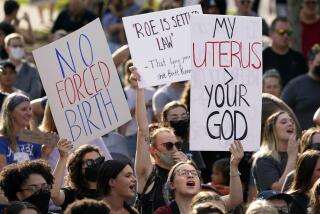Navy to Reopen Iowa Inquiry, Bans Firing Guns : Explosion: The service takes action after gunpowder tests call into question earlier theories of the cause of the ship’s fatal accident in April, 1989.
- Share via
WASHINGTON — The Navy will reopen its controversial investigation of the 1989 explosion aboard the battleship Iowa that killed 47 sailors because an “unexplained ignition” of gunpowder occurred Thursday during tests.
The renewal of the investigation, ordered Thursday by Secretary of the Navy H. Lawrence Garrett III, calls into question the Navy’s earlier conclusion that the fatal blast in the Iowa’s central gun turret was “most probably” caused by 24-year-old Gunner’s Mate Clayton M. Hartwig in a bizarre murder-suicide.
It also constitutes an embarrassing turn of events for the Navy. Last September, after spending $2.4 million on 45,669 hours of technical testing, the Navy declared that the kind of gunpowder that exploded Thursday could not have been ignited without a detonator.
And only weeks ago, Navy officials brushed aside other research which suggested that accidental detonation of the 600-pound bags of powder used in the Iowa’s big guns was indeed possible. The tests that resulted in Thursday’s accidental explosion were apparently a belated follow-up on that research, performed through computer simulations at the Department of Energy’s Sandia National Laboratory.
In addition to reopening the Iowa inquiry, Garrett also banned--for the second time in a little more than a year--all firing of the 16-inch guns aboard the nation’s four operating battleships.
Sen. Carl Levin (D-Mich.), a member of the Senate Armed Services Committee Thursday denounced as “irresponsible” the Navy’s decision not to ban the firing of 16-inch guns immediately upon learning of the Sandia findings.
“Today’s incident could have been yet another tragedy at sea if it had occurred on one of the Navy’s battleships,” Levin said.
At the time the Navy was notified of the Sandia report, the Long Beach-based battleship Missouri, which is also equipped with 16-inch guns, was at sea and operating under orders that would have permitted firing of those guns.
Navy officials said that Garrett will reexamine the findings of the original Iowa investigation when the current follow-up testing is completed.
Thursday’s unexpected explosion occurred at the Navy’s Surface Warfare Center in Dahlgren, Va. No one was injured.
Hartwig’s family in Cleveland, Ohio, hailed it as evidence that the gunner’s mate had been wrongly found at fault.
“The Navy has got to do an awful lot of apologizing to 47 families for the wrongful attitude they used . . . and for what my wife and I have gone through for the last year, claiming my son did this,” Earl Hartwig, Clayton’s father, told United Press International Thursday. “They just ruined his name.”
Rep. Nicholas Mavroules (D-Mass.), who spearheaded a critical House Armed Services Committee investigation of the Navy inquiry, said Thursday he is “delighted” that the case will be reopened.
“I’m not saying the new investigation will come out with a new conclusion but the Navy has seen enough evidence to call for a new one,” said Mavroules, whose subcommittee in March concluded that the Navy had been hasty in placing the blame on Hartwig, whose psychological profile had been equivocal.
“All I asked is that they get into this very deeply. If you’re going to investigate, investigate everything,” Mavroules said Thursday. “Unless you’re 100% sure and can document that conclusion, you just don’t come out and point your finger at someone,” he added.
Thursday’s explosion and the reopening of the Iowa investigation are expected to be the principle focus of a Senate Armed Services Committee hearing today.
After an extensive investigation of Hartwig, the Federal Bureau of Investigation concluded that the sailor “died as a result of his own actions, staging his death in such a fashion that he hoped it would appear to be an accident.”
The Navy accepted the FBI’s assessment and formally concluded that Hartwig, who appeared to have been the last sailor to have touched the bags of propellant, “most probably” committed the “wrongful intentional act” of igniting the blast by inserting a detonator into the gunpowder bags.
But the Navy’s analysis was challenged earlier this month by scientists at Sandia, who found in computer simulations that the blast could have been caused by an overly rapid insertion of gunpowder bags into the breech of the gun, and by “impact sensitivity of the propellent.”
According to a May 14, 1990, letter from Sen. Sam Nunn (D-Ga.), chairman of the Senate Armed Services Committee, to Adm. Carlisle A. H. Trost, chief of naval operations, the Navy’s initial reaction to Sandia’s findings was that “they were not relevant” because they had not been performed on the 16-inch guns.
In response to the inquiries of Senate Armed Services Committee staff members, the Navy said that “no action need be taken,” Nunn reported in a letter obtained by The Times.
The nation’s four battleships, two of which use Long Beach as their home port, were recommissioned in the early 1980s at a cost of about $1.7 billion. The warships are the only vessels in the U.S. arsenal that carry the 16-inch guns, which are capable of hurling projectiles weighing as much as 2,700 pounds over distances of as much as 18 miles.
In the wake of the Iowa tragedy, Navy engineers estimated that it would cost millions of dollars to repair the center turret in which the explosion occurred.
The prospects of such a repair, in addition to the unusually high cost of manning and operating the battleships, led Defense Secretary Dick Cheney in January to propose the decommissioning next year of two of the dreadnoughts.
More to Read
Sign up for Essential California
The most important California stories and recommendations in your inbox every morning.
You may occasionally receive promotional content from the Los Angeles Times.














